Managing Tasks
This section discusses:
Task Management WorkCenter.
Assigning tasks to students in batch.
Managing tasks using the Task List component.
Managing tasks using the PeopleTools components.
Viewing or updating a student agreement.
Viewing task activity.
Using Batch Notifications process for sending reminders.
Updating tasks in batch.
Deleting tasks in batch.
|
Page Name |
Definition Name |
Navigation |
Usage |
|---|---|---|---|
|
Task Management WorkCenter |
SCC_TM_ADMN_WRKCTR |
|
Configure and manage tasks. |
|
Assign Tasks |
SCC_TM_BAT_CREATE |
|
Run the process to assign tasks to students in batch based on Population Selection or Student Groups. You can also run this process for individual students. |
|
Task List |
SCC_TM_ADM_LIST |
|
Search for tasks assigned to students. Manage tasks assigned to students, for example, adding action items and changing the status to In Progress or Complete. |
|
View Agreements |
SCC_TM_AGRMNT |
|
Search for agreement records of students. View and update agreement records of students. |
|
View Task Activity |
SCC_TM_TASK_LOG |
|
View updates to tasks that students have made via the Student Task WorkCenter. |
|
Batch Notifications |
SCC_BAT_NTF |
|
Run the process to generate reminder notifications in batch for In Progress tasks based on Population Selection. |
|
Update Tasks |
SCC_TM_BAT_UPDATE |
|
Update Activity Guide instances based on Population Selection. You can update tasks for an individual or a group. |
|
Delete Tasks |
SCC_TM_BAT_DELETE |
|
Delete Activity Guide instances based on Population Selection. You can delete tasks for an individual or a group. |
Task Management WorkCenter offers you access to task transactions from one central location. You can use this WorkCenter to configure and manage tasks for Campus Solutions. Access the Task Management WorkCenter ().
This example illustrates the fields and controls on the Task Management WorkCenter.
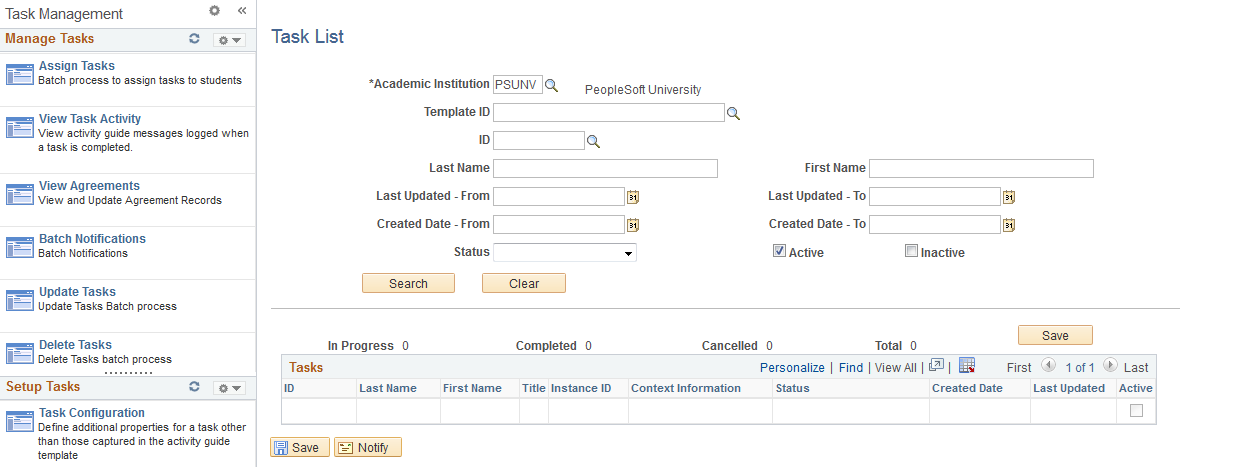
For information about using the links on this page, see:
Task Management WorkCenter is a PeopleTools Portal – WorkCenter page. For information about the WorkCenter, see Understanding WorkCenters and Dashboards.
Access the Assign Tasks page ().
This example illustrates the fields and controls on the Assign Tasks page. You can find definitions for the fields and controls later on this page.
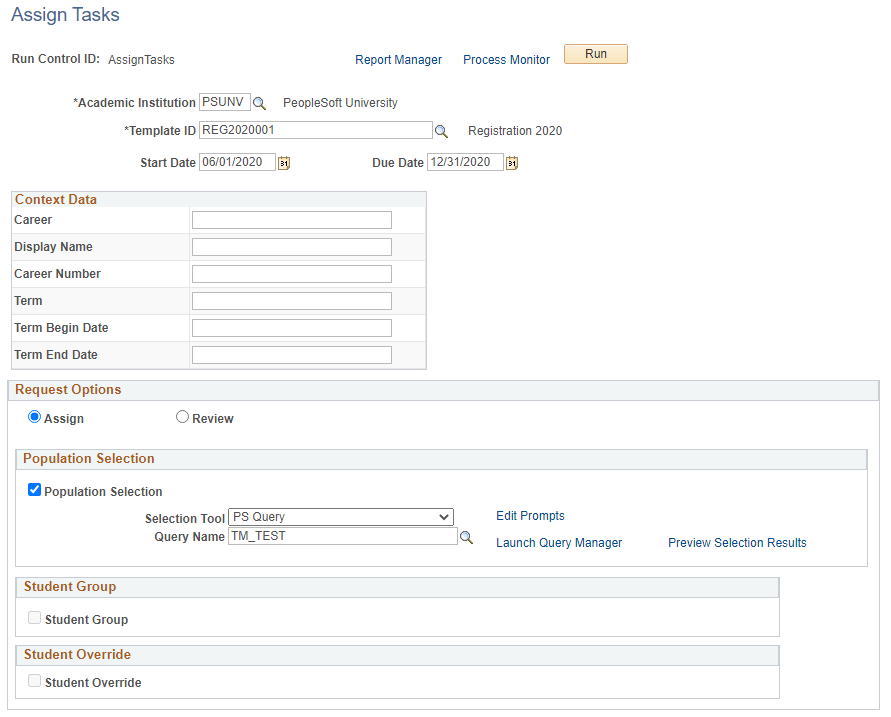
Field or Control |
Description |
|---|---|
Start Date |
(Optional) Enter the task’s start date. If the instance is created by the Assign Tasks process, the start or due date value at the instance level is derived from the value you define here or in Due Date. Otherwise, the value is derived from the dates you defined on the template. |
Due Date |
(Optional) Enter the task’s due date. In the To Do List, this date appears as the instance due date. |
Assign |
Select to run the Assign Tasks process based on the chosen request options (Population Selection, Student Group or Student Override). |
Review |
Select to run the process in review mode. This option can be used to review the current task records against the population selection criteria originally used to create the tasks and identify students who no longer meet the criteria for the task or whose context data has changed and needs to be updated. If you select this option, only Population Selection is available (Student Group and Student Override become unavailable). When you select this option, the process compares the population and the assigned In Progress tasks to determine:
The process adds the results of this comparison in a log file that you can review. |
In Assign mode, the Assign Tasks process creates the tasks and populates the context data. The process also handles the checking of prerequisite tasks and triggering of assignment notifications.
For each instance, the Administrator roles defined for the template are copied to the instance. A security record with the Privilege Set ID of Contributor is created for the User ID related to the EMPLID, rather than a Role defined for the template (for example, CS - Student for the delivered templates).
If there is no User ID associated with the EMPLID, the instance is created without a defined Contributor and a message is logged. If the EMPLID is associated with multiple User IDs, Contributor records are created for each User ID and a message is logged.
For each record, the process performs the following:
If any prerequisite task defined in the Task Configuration component is not complete, the process does not create the task for that student, logs a message and skips to the next student record.
If there is an existing task for the student (that is, activity guide instance with all context data is matching), the process does not create a task for that student, logs a message indicating that the task already exists and skips to the next student record.
If the process passes all the above validations, it creates a new activity guide instance for the student and populates the context data, logs a message with the student details confirming that the task has been created.
For each new activity guide instance created, if a notification has been defined with Trigger = Assigned in the Task Configuration component, the process triggers a new notification for the student.
For Fluid tasks, if the Push Notifications check box is selected, an Alert is generated in the Fluid Notifications flag with a link to access the task.
In review mode, the Assign Tasks process performs the following:
For the purposes of matching the population and In Progress tasks, the context data values for the population are taken either from the PS Query results or from the Context Data parameter fields.
Step 1. Review population against tasks
For each record in the population:
If there is a matching activity guide instance for the Template ID, Institution, EMPLID and all the context data and:
If the instance status is Cancelled, the process logs a message stating that the task is cancelled for the ID.
If the instance is In Progress or Complete, the process does not log a message.
If there is a matching activity guide instance for the Template ID, EMPLID and Institution but not all the context data matches, then the process logs a message stating that the context information of the task does not match.
If there is no matching activity guide instance for the Template ID, Institution and EMPLID, then the process logs a message stating that the task is not assigned to the student.
Step 2. Review tasks against population
For each current task (that is, activity guide instance with status In Progress) for the Template ID and institution (note: the process does not consider cancelled and completed tasks):
If the student is not in the population, the process logs a message stating that the ID, status and task context is not included in the population.
Context Data
Use this group box to specify the context data parameters.
The system dynamically displays the context data fields in this group box for the template that you have selected.
If you are using Population Selection, then the context data values can come from the query results. In such a case, you need not populate the context data fields. If you are using either Student Group or Student Override or Population Selection with a query that only returns EMPLIDs, then you must specify all the context data values (except Student ID and Institution) that the process uses to create the tasks.
Field or Control |
Description |
|---|---|
Student ID |
This is not displayed in Context Data. The value is derived from the Population Selection, Student Group or Student Override parameters you specify on this page. |
Institution |
This is not displayed in Context Data. The value is derived from the value you enter in the Academic Institution field of this page. |
Population Selection
Population selection is a method for selecting the IDs to process for a specific transaction. Currently, the Assign Tasks process supports only PS Query for selecting the IDs.
See Understanding the Population Selection Group Box
Select the Population Selection check box.
The Assign Tasks process can be run for a group of students returned by a query. The minimum a query needs to return are the EMPLID values for students. If the query also returns context data values, then those override any context data parameters specified in the Context Data group box. In addition to EMPLID, context data values can be populated from a query for Career (ACAD_CAREER), Career Number (STDNT_CAR_NBR), Term (STRM), Academic Plan (ACAD_PLAN), Class Number (CLASS_NBR), and Session (SESSION_CODE).
Field or Control |
Description |
|---|---|
Query Name |
Select an existing query in the system. The SCC_TM_PPL_SRCH_QRY predefined query is delivered. This sample query returns all the context data required for use with the Program Registration template. |
Student Group
Use this group box if you want to run the process for a select group of students.
See Understanding Student Groups
Note: You must specify the context data parameters in the Context Data group box if you are running the process for a student group.
Student Override
Field or Control |
Description |
|---|---|
Student Override |
Select if you want to run the process for the IDs selected in the EmplID field. |
ID (employee ID) |
Enter the IDs of one or more students to whom the process should assign the task. |
Note: You must specify the context data parameters in the Context Data group box if you are using the Student Override group box.
Translated Tasks
When an instance is created, instance language records are created as follows:
Full Translation is done when one of the following conditions is true:
The template has been created using Activity Guide Composer and the Translation Option is Full Translation.
The template has been created using PeopleTools Manage Templates and the Generate instance data for all languages check box is selected.
The PeopleTools level is lower than 8.58.
All the language records defined for the template and its action items are created at instance level. This applies whatever user profile language is defined and whatever language is used to log in.
Partial Translation is done when the user running the Assign Tasks process has a user profile language other than the base language and one of the following conditions is true:
The template has been created using Activity Guide Composer and the Translation Option is Partial Translation.
The template has been created using PeopleTools Manage Templates and the Generate instance data for all languages check box is not selected.
All language records defined for the template and its action items for the user profile language are created at instance level.
Note: Partial Translation for instances created via the PeopleTools Create Instance page are based on the logged-in language of the user rather than the user profile language that is used by the Assign Tasks process.
The Task List page has an enhanced functionality when compared with the PeopleTools - Manage Activity Guide Instances page. For example, the Task List page provides more search options and enables you to identify the EMPLID of the student to whom the task is assigned.
Access the Task List page ().
This example illustrates the fields and controls on the Task List page. You can find definitions for the fields and controls later on this page.
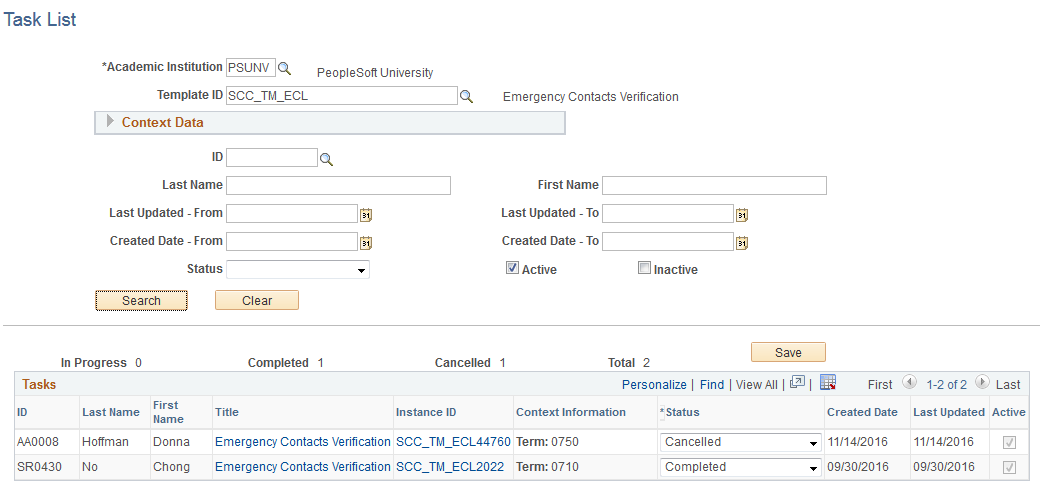
Field or Control |
Description |
|---|---|
Template ID |
The prompt values are based on the institution that you select. The system also restricts these prompt values based on security settings (member privileges) of the template. That is, you can select a template in this field only if you have the security access for the template. |
Last Updated – From and Last Updated – To |
Use these fields to narrow the search to only those tasks that have been updated by the institution or students within this range. |
Created Date – From and Created Date – To |
Use these fields to narrow the search to only those tasks that have been created by the institution within this range. |
Tasks
Field or Control |
Description |
|---|---|
Title |
Click to access a PeopleTools - activity guide component where you can view the action items of the instance. |
Instance ID |
Click to access a PeopleTools - activity guide component where you can view the properties of the instance. |
Context Information |
Displays the context data (except Institution and EMPLID) for the task. |
Status |
If needed, change the task status. Available statuses include Cancelled, In Progress and Completed. |
If you do not have security access to the instance, the search results displays the instance with the Title and Instance ID links disabled.
See the product documentation for PeopleTools: Portal Technology, Managing activity guide instances.
You can use the PeopleTools Activity Guide components to manually create an instance (task for a student), based on a template. For example, to create an instance based on a template, you can use the Create Instance button on the Activity Guide Template - Properties page. In other words, you can use the button to manually assign a task to a student that the student needs to complete.
Note that the same Instance Creation method is used by the PeopleTools Activity Guide components when you manually create an instance and the Assign Tasks process.
Use the PeopleTools - Manage Activity Guide Instances page to manage instances, for example, adding action items to an instance or deleting instances. You can access this page from the PeopleTools menu or from the Task Management WorkCenter.
Refer to the PeopleTools: Portal Technology documentation for information on creating instances and for fields on the PeopleTools - Manage Activity Guide Instances page.
See the product documentation for PeopleTools: Portal Technology, Managing activity guide instances.
To search for agreement records, access the View Agreements page ().
This example illustrates the fields and controls on the View Agreements page. You can find definitions for the fields and controls later on this page.
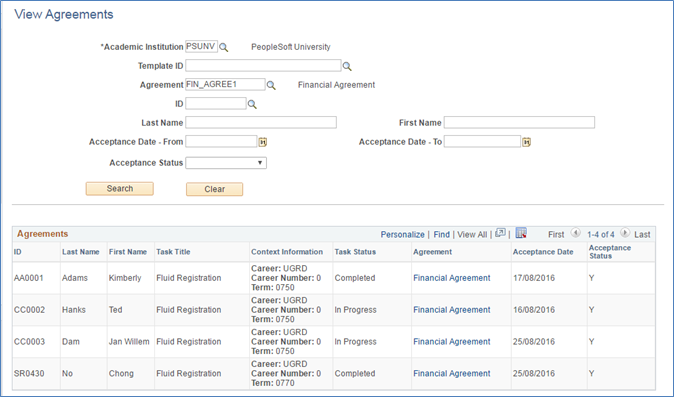
Field or Control |
Description |
|---|---|
Template ID |
The prompt values are based on the institution that you select. The system also restricts these prompt values based on security settings (member privileges) of the template. That is, you can select a template in this field only if you have the security access for the template. |
Click the Agreement link in a search record to access the View Agreement Detail page.
This example illustrates the fields and controls on the View Agreement Detail page. You can find definitions for the fields and controls later on this page.

This page enables you to view an agreement for audit purposes and as an administrator complete an agreement on behalf of a student (for example, after a student has declined an agreement, printed and signed the agreement and returned a paper copy).
Field or Control |
Description |
|---|---|
Attachments |
Click to access the Agreement Attachments page where you can view, add or delete attachments related to the agreement. You can add an attachment of a scanned signed paper agreement. |
Acceptance Status |
Use this check box if student has submitted a paper agreement. Select the check box to indicate that the student has accepted the agreement. Clear the check box to indicate that the student has not accepted the agreement. |
Comment |
Enter any comments if you have changed the acceptance status. |
Last Updated and Last Updated By |
The date and time at which the page was last updated and the name of the user who updated the page. |
When you click the Save button and if the Acceptance Status check box has been selected, then the system updates the status of the associated action item to Completed. If all the required action items (that is, action items with the Required check box selected on the Action Item Details page) for the task are now set to Completed, the system performs the following processing (which is the same processing the system performs when the student clicks the Finish button on the Complete Task page):
Updates instance status to Complete.
Triggers the complete notification.
Creates subsequent tasks.
Releases service indicators.
The View Agreements page is updated to also display those agreements where the related instance has been deleted either through the Manage Instances page or by the Delete Tasks process. In such cases, the Task Title is displayed from the related template and Context Information is blank. The Task Title is derived from the first 10 characters of the Instance ID held in the agreement record matched to the Template ID. The Task Status column displays Deleted in place of the instance status.
Note: You cannot search by Template ID to find agreements for a deleted instance.
Note: The Acceptance Status and Comment fields can still be updated for agreements associated with deleted instances.
Access the View Task Activity page ().
This example illustrates the fields and controls on the View Task Activity page. You can find definitions for the fields and controls later on this page.

This page displays records based on the activity guide messages that the system logs when a task is completed.
Messages are logged for the following actions when a student completes a task:
The task status is updated to Complete.
A new subsequent task is created for the student.
A subsequent task cannot be created because the current task does not have all the required context data.
A subsequent task is not created because it already exists for the student.
Field or Control |
Description |
|---|---|
Template ID |
The prompt values are based on the institution that you select. The system also restricts these prompt values based on security settings (member privileges) of the template. That is, you can select a template in this field only if you have the security access for the template. |
Task Activity
Field or Control |
Description |
|---|---|
Title |
Click to access a PeopleTools- activity guide component where you can view the action items of the instance. |
Instance ID |
Click to access a PeopleTools- activity guide component where you can view the properties of the instance. |
If you do not have security access to the instance, the search results displays the instance with the Title and Instance ID links disabled.
Access the Batch Notifications run control page ().
This example illustrates the fields and controls on the Batch Notifications page (1 of 2)

This example illustrates the fields and controls on the Batch Notifications page (2 of 2)
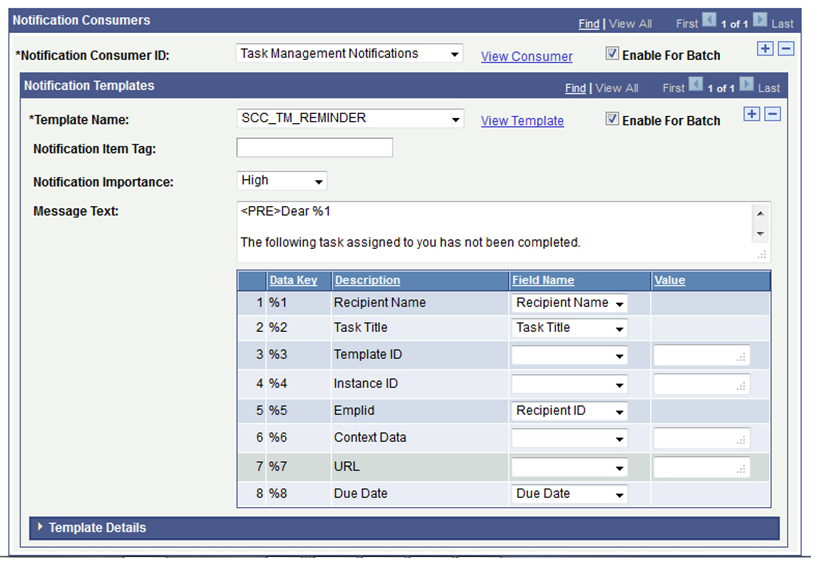
You can use the Notifications Framework’s Batch Notification process for sending reminder notifications to students with incomplete tasks.
Delivered with the system are the Notification Consumer ID Task Management Notifications (SCC_NTF_CON_20130619110938) and the notification setup for an example generic template SCC_TM_REMINDER.
An example PS Query is delivered (SCC_TM_POP_TASK_REMINDER) that you can use for this process. This query returns all the In Progress tasks with the data required to populate the example generic template.
Note: If you are creating your own query, then the query needs to include PEOPLE_SRCH.
In the Batch Notification page, after selecting the Query Name, click Edit Prompts to add the Academic Institution and Template ID values for the task. After selecting the Notification Consumer ID and Template Name, define the Field Name value for each of the variables used in the Message Text region.
A PS Query cannot provide the student/task specific URL to open the Student Task WorkCenter. Therefore, if you want to include a URL in the email, then define the URL in the Value field. The URL can point to the Student Center or to the Current Tasks pagelet and the student can then click the task link to complete the task. Note that the URL cannot be defined to directly open the Student Task WorkCenter for the task because the batch process is generating notifications for multiple students.
Use this batch process to update Activity Guide instances. You can select instances for updating based on Institution, Template ID, Existing Status, and Context Data values (such as, the STRM value for Fluid Registration).You can refine your search by selecting either Population Selection or Student Override methods.
A user with HCCPCSSA1000 CS Administration – All Pages permissions can use the Update Tasks process.
Access the Update Tasks page ().
This example illustrates the fields and controls on the Update Tasks page. You can find definitions for the fields and controls later on this page.
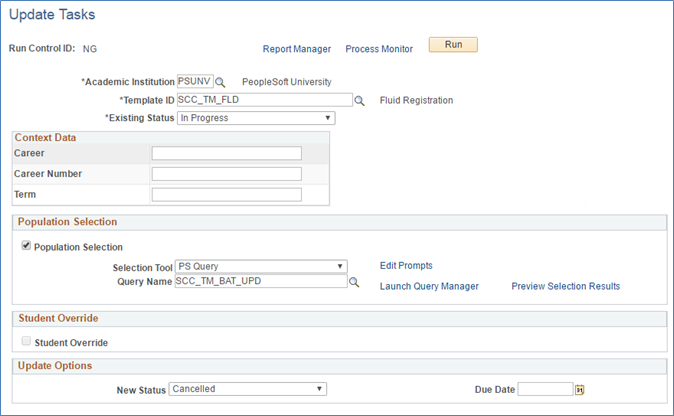
Field or Control |
Description |
|---|---|
Template ID |
Select a value prompted by the user’s administrator access. |
Existing Status |
Select a value based on translate values for SCC_TM_EX_STATUS: All (AL), In Progress (IP), Cancelled (CA) and Completed (CP). The default is In Progress (IP). The process only updates instances with the selected Status. To update instances irrespective of Status, select All. Note: An institution can deactivate codes according to need. For example, removing All and Completed, would restrict updates to In Progress and Cancelled instances. |
Context Data |
Enter values by which to filter the updated instances. You cannot use Institution as that is filtered using Academic Institution, or Student ID as that is filtered using either Population Selection or Student Override. |
Population Selection |
Select PS Query as the Selection Tool. Select a Query Name based on the SCC_TM_PTAILIST record. The query should return the records for the selected Institution and Template ID that are to be updated. An example query SCC_TM_BAT_UPD, is delivered with prompts for Institution and Template ID that should be set to match the process parameters. You must select either Population Selection or Student Override to run the process. |
Student Override |
Select the check box to view a Students grid, in which you can search for specific EMPLIDs. You must populate the grid with at least one ID. |
Update Options |
Select a new, updated status for the selected instances: In Progress (IP), Cancelled (CA) or Completed (CP). Update the existing Due Date of the selected instances. You must select either or both, the New Status and Due Date, to run the process. |
The Update Tasks process comprises the selection of the instances and their update:
Task selection: You can run the Update Tasks process only on instances that meet all of the following conditions:
The Institution parameter matches the value in the Context Data for the instance.
The Template ID parameter matches the parent template of the instance.
The Existing Status parameter is All or matches the instance status.
Any other provided Context Data parameters match the equivalent values for the instance.
If a PS Query is defined under Population Selection, the Instance ID appears in the query results.
If Student Override is selected, the EMPLID in the Context Data for the instance matches one of the defined IDs.
Note: The instance Active flag is not considered unless added as one of the criteria in the PS Query.
Note: Even if you use a PS Query to determine the Instance IDs for the records to be updated, the process also matches the Institution, Template and Existing Status parameters before execution.
Task update: The process performs the following on each selected instance:
If the user does not have security access to the instance, the instance is not updated and an error message is logged.
If a New Status value is provided, the existing status value is updated and a confirmation message is logged. If the status is being updated to Completed, the following processing based on Task Configuration is performed.
Remove service indicators.
Create any subsequent tasks.
Remove any push notifications for the instance (Fluid instances only).
Note: A Task completed message is not saved in the task activity log.
Complete task notifications are not triggered.
The statuses of individual action items are not updated and agreements are not completed or saved on behalf of the student.
If a new Due Date value is provided:
If the new Due Date is earlier than the existing Start Date of the instance, the Due Date of the instance is not updated and a message is logged.
If the new Due Date is on or after the existing Start Date, or the existing Start Date is blank, the Due Date of the instance is updated and a confirmation message is logged.
For each updated instance, the last update date/time is updated to current date/time and the last update Operator ID is updated to the user running the process.
Use this batch process to delete incomplete or cancelled Activity Guide instances. You can select instances for deleting based on Institution, Template ID, Existing Status, and Context Data values. You can refine your search by selecting either Population Selection or Student Override methods.
A user with HCCPCSSA1000 CS Administration – All Pages permissions can use the Delete Tasks process.
Access the Delete Tasks page ().
This example illustrates the fields and controls on the Delete Tasks page.

The fields and controls on the Delete Tasks page are the same as those on the Update Tasks page. For details, see Updating Tasks in Batch.
The Delete Tasks process comprises the selection of the instances and their deletion:
Task selection: You can run the Delete Tasks process only on instances that meet all the required conditions described in the Update Task instance selection process.
Task delete: If the user running the process has security access, the process deletes the instance record and associated action items for every selected instance, and a confirmation message is logged.
Note: The Delete Tasks process does not delete the Agreement records associated with the instances being deleted.